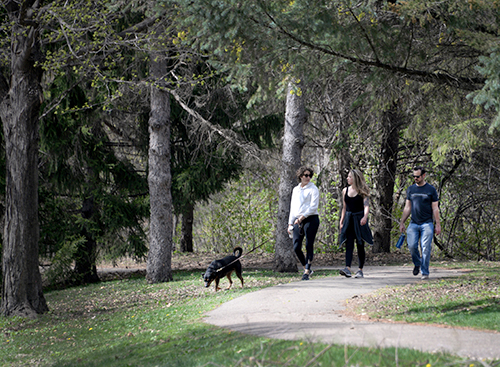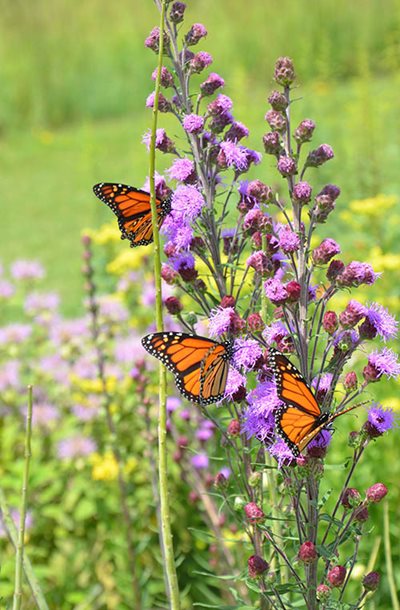 Visits to regional parks and trails continued to trend upward in 2019, climbing to an estimated 63.3 million visits. The estimate is the highest on record and represents a 6.3% increase over 2018.
Visits to regional parks and trails continued to trend upward in 2019, climbing to an estimated 63.3 million visits. The estimate is the highest on record and represents a 6.3% increase over 2018.
The regional system of parks and trails features 44 regional parks, 12 park reserves, 49 regional trails, and eight special recreation features, including Como Park Zoo and Conservatory, Noerenberg Gardens on Lake Minnetonka, and Gale Woods Farm in Minnetrista.
The Metropolitan Council produces the annual estimates (PDF) with the help and support of 10 park agencies, including cities, counties, and special park districts. The Minneapolis Park and Recreation Board had the highest number of visits among the 10 agencies in 2019 with approximately 23.6 million visits, followed by Three Rivers Park District (12.6 million) and the City of Saint Paul (9.6 million).
“Local and regional leaders have had the foresight and commitment to establish and identify land for the vast network of parks and open space we enjoy in the Twin Cities region,” said Council Chair Charlie Zelle. “We celebrate them by paying visits and continuing to support access to and expansion of these remarkable regional assets.”
“We appreciate our regional parks and trails for the abundance of opportunity they provide to play, recreate, gather, and exercise,” said Parks Unit Manager Emmett Mullin. “But they contribute to our quality of life in so many other ways. They allow us to connect with nature, protect and preserve the natural environment, habitat, and wildlife. And, they enhance our communities as well as our well-being,” said Mullin.

Minneapolis Chain of Lakes continues to lead in visits
Among the most visited regional parks in 2019:
-
Minneapolis Chain of Lakes Regional Park: 8.0 million visits
-
Como Regional Park, Zoo, & Conservatory: 3.8 million visits
-
Central Mississippi Riverfront Regional Park: 3.6 million visits
-
Mississippi Gorge Regional Park: 3.1 million visits
-
Minnehaha Regional Park: 2.5 million visits
-
Nokomis-Hiawatha Regional Park: 2.0 million visits
-
Minnehaha Parkway Regional Trail: 1.5 million visits
-
Elm Creek Park Reserve: 1.5 million visits
-
Phalen Regional Park: 1.3 million visits
-
Lilydale-Harriet Island Regional Park: 1.2 million visits
Other key findings in the annual Regional Park System Use Estimate Report (PDF):
-
Summer 2019 visitors to the Regional Parks System included an estimated 12,000 scooter riders and 387,000 cyclists. The system includes nearly 400 miles of trails, with annual trail use of more than 15 million visits.
-
Campers made more than 360,000 visits to campgrounds in 2019 in Carver, Anoka, Dakota, Scott, and Washington counties, as well as within the Three Rivers Park District.
Developing/maintaining regional parks takes partnerships
The Metropolitan Council is charged with overseeing the acquisition and development of regional parks and trails. Operations are in the hands of 10 partner cities, counties and special districts. We have produced annual parks use estimates since 1995.
Park and trail funding comes from a variety of sources, including the State of Minnesota's Clean Water, Land & Legacy Amendment, state and regional bonding, and the Environment and Natural Resources Trust Fund.
Council parks policies support preservation, growth, access, and equity
Parks promote vibrant communities and healthy people. Regional and local park agency policies are committed to:
-
Expanding the Regional Parks System to conserve, maintain, and connect natural resources identified as being of high quality or having regional importance.
-
Providing a comprehensive regional park and trail system that preserves high-quality natural resources, increases climate resiliency, fosters healthy outcomes, connects communities, and enhances quality of life in the region.
-
Promoting expanded, multimodal access to regional parks, regional trails, and the transit network, where appropriate.
-
Strengthening equitable use of regional parks and trails by all our region’s residents, such as across age, race, ethnicity, income, national origin and ability.
Note: We will not produce 2020 parks use estimates due to the unusual circumstances surrounding the COVID-19 virus. Regional parks are experiencing heavy use and park agencies encourage safe practices to protect public health that include social distancing, staying home if sick, and frequent hand washing.